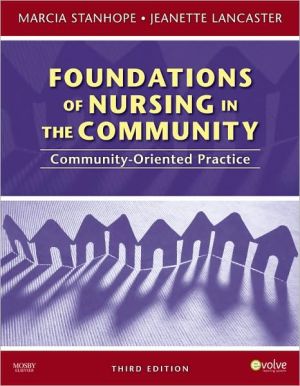The Hidden Epidemic: Confronting Sexually Transmitted Diseases
The United States has the dubious distinction of leading the industrialized world in overall rates of sexually transmitted diseases (STDs), with 12 million new cases annually. About 3 million teenagers contract an STD each year, and many will have long-term health problems as a result. Women and adolescents are particularly vulnerable to these diseases and their health consequences. In addition, STDs increase the risk of HIV transmission.\ The Hidden Epidemic examines the scope of sexually...
Search in google:
The United States has the dubious distinction of leading the industrialized world in overall rates of sexually transmitted diseases (STDs), with 12 million new cases annually. About 3 million teenagers contract an STD each year, and many will have long-term health problems as a result. Women and adolescents are particularly vulnerable to these diseases and their health consequences. In addition, STDs increase the risk of HIV transmission.The Hidden Epidemic examines the scope of sexually transmitted infections in the United States and provides a critical assessment of the nation's response to this public health crisis. The book identifies the components of an effective national STD prevention and control strategy and provides direction for an appropriate response to the epidemic. Recommendations for improving public awareness and education, reaching women and adolescents, integrating public health programs, training health care professionals, modifying messages from the mass media, and supporting future research are included.The book documents the epidemiological dimensions and the economic and social costs of STDs, describing them as "a secret epidemic" with tremendous consequences. The committee frankly discusses the confusing and often hypocritical nature of how Americans deal with issues regarding sexuality--the conflicting messages conveyed in the mass media, the reluctance to promote condom use, the controversy over sex education for teenagers, and the issue of personal blame.The Hidden Epidemic identifies key elements of effective, culturally appropriate programs to promote healthy behavior by adolescents and adults. It examines the problem of fragmentation in STD services and provides examples of communities that have formed partnerships between stakeholders to develop integrated approaches.The committee's recommendations provide a practical foundation on which to build an integrated national program to help young people and adults develop habits of healthy sexuality.The Hidden Epidemic was written for both health care professionals and people without a medical background and will be indispensable to anyone concerned about preventing and controlling STDs. Booknews The results of an investigation by the US Committee on Prevention and Control of Sexually Transmitted Diseases surveying the scope of STDs and pronouncing their proliferation a national health crisis. The report presents scary evidence on the health and economic impact of STDs, discussing the factors that contribute to the epidemic, prevention, current clinical services, and finally recommending a plan for establishing an effective national system to prevent STDs. The ten appendices offer additional information associated with the various diseases, their transmission, and the effectiveness of various care services. Annotation c. by Book News, Inc., Portland, Or.
The Hidden Epidemic \ Confronting Sexually Transmitted Diseases\ \ NATIONAL ACADEMIES PRESS \ Copyright © 1997 National Academy of Sciences\ All right reserved.\ ISBN: 978-0-309-05495-9\ \ \ \ Chapter One \ Executive Summary\ Sexually transmitted diseases (STDs) are hidden epidemics of tremendous health and economic consequence in the United States. They are hidden from public view because many Americans are reluctant to address sexual health issues in an open way and because of the biological and social factors associated with these diseases. In addition, the scope, impact, and consequences of STDs are underrecognized by the public and health care professionals.\ Of the top ten most frequently reported diseases in 1995 in the United States, five are STDs. Rates of curable STDs in the United States are the highest in the developed world and are higher than in some developing regions. Approximately 12 million new cases of STDs, 3 million of them among teenagers, occur annually. The committee estimates that the annual direct and indirect costs of selected major STDs are approximately $10 billion or, if sexually transmitted HIV infections are included, $17 billion. Along with the human suffering associated with STDs, this cost is shared by all Americans through higher health care costs and taxes. STDs represent a growing threat to the nation's health and national action is urgently needed.\ The term "STD" denotesthe more than 25 infectious organisms that are transmitted through sexual activity, along with the dozens of clinical syndromes that they cause. The spectrum of health consequences ranges from mild acute illness to serious long-term complications such as cervical, liver, and other cancers and reproductive health problems. Women and infants bear a disproportionate burden of STD-associated complications. A variety of women's health problems, including infertility, ectopic pregnancy, and chronic pelvic pain, result from unrecognized or untreated STDs. From 1973 through 1992, more than 150,000 U.S. women died of causes associated with STDs (including HIV infection) and their complications. Women are particularly vulnerable to STDs because they are more biologically susceptible to certain sexually transmitted infections than men and are more likely to have asymptomatic infections that commonly result in delayed diagnosis and treatment. Active infection with STDs during pregnancy may result in a range of serious health problems among infected infants, including severe central nervous system damage and death. Adolescents are at greatest risk of STDs because they frequently have unprotected sexual intercourse, are biologically more susceptible to infection, and are likely to have social problems that significantly increase their risk.\ STDs are difficult public health problems because of the "hidden" nature of these diseases. The sociocultural taboos related to sexuality are a barrier to STD prevention efforts on a number of levels. Effective STD prevention efforts also are hampered by biological characteristics of STDs, societal problems, unbalanced mass media messages, lack of awareness, fragmentation of STD-related services, inadequate training of health care professionals, inadequate health insurance coverage and access to services, and insufficient investment in STD prevention.\ Although the barriers to STD prevention are formidable, STDs can be prevented by intervening at multiple points with behavioral, biomedical, and structural interventions on both individual and community levels. These and other effective interventions, however, are not being fully implemented or utilized. Because STDs are complex diseases that are associated with a variety of social issues and involve a wide spectrum of stakeholders in the community, a collaborative, multifaceted approach to STD prevention is essential.\ CONCLUSIONS AND RECOMMENDATIONS\ The committee concludes that an effective national system for STD prevention currently does not exist and, as a result, STDs are a severe health burden in the United States. Many components of the system need to be redesigned and improved through innovative approaches and closer collaborations. In addition, programs that address important gaps in the current fragmented system of services have not yet been designed and implemented. The committee's recommendations are outlined below and presented in complete detail in Chapter 6.\ In formulating a strategy to prevent STDs, the committee developed the following vision statement to guide its deliberations.\ Vision\ An effective system of services and information that supports individuals, families, and communities in preventing STDs, including HIV infection, and ensures comprehensive, high-quality STD-related health services for all persons.\ This vision and the committee's proposed model for improving STD prevention are founded on a multifaceted approach to prevention, shared responsibility and active participation by individuals and the community, coordination of related programs, and adequate resources and support for implementation.\ To realize this vision, the committee recommends that:\ An effective national system for STD prevention be established in the United States.\ The committee envisions a system based on national policy, coordinated at all levels, and composed of local, state, and national prevention programs. A national system is essential because STDs are a threat to the nation's health, because many interventions are most effectively or efficiently developed and implemented at the national level, and because STDs do not recognize geographic borders.\ To establish a national system for STD prevention, the committee recommends four major strategies for public and private sector policymakers at the local, state, and national levels:\ 1. Overcome barriers to adoption of healthy sexual behaviors.\ 2. Develop strong leadership, strengthen investment, and improve information systems for STD prevention.\ 3. Design and implement essential STD-related services in innovative ways for adolescents and underserved populations.\ 4. Ensure access to and quality of essential clinical services for STDs.\ Before describing the recommended tactics for these four strategies, the committee makes the following recommendations regarding two important concepts that need to be incorporated into a national strategy to prevent STDs: the impact of STDs on HIV transmission and the impact of STDs on cancer.\ Improved prevention of STDs should be an essential component of a national strategy for preventing sexually transmitted HIV infection.\ Government agencies and private organizations concerned with cancer prevention should support STD prevention activities as an important strategy for prevention of STD-related cancers.\ Strategy 1: Overcome barriers to adoption of healthy sexual behaviors.\ Barriers to effective STD prevention efforts include biological, social, and structural factors. One of the primary obstacles is this country's reluctance to openly confront issues regarding sexuality and STDs. Failure to acknowledge and discuss sexuality impedes STD education programs, open communication between parents and their children and between sex partners, balanced messages from mass media, education and counseling activities of clinicians, community activism for STDs, and behavioral research.\ Catalyzing Change Through Open Discussion and Promoting Awareness and Balanced Mass Media Messages\ A new social norm of healthy sexual behavior should be the basis for long-term prevention of STDs. This is because in one way or another all interventions to prevent STDs are partly dependent on, and must be integrated with, healthy behaviors. In order for societal norms regarding sexual behavior to change, open discussion of and access to information regarding sexual behaviors, their health consequences, and methods for protecting against STDs must occur. Therefore, the committee believes that a significant national campaign to foster social change toward a new norm of healthy sexual behavior in the United States is necessary. An independent entity is needed to promote a social norm of healthy sexual behavior because, based on experience with past initiatives, limitations on government agencies regarding public education programs related to sexuality are particularly problematic.\ Lack of awareness regarding STDs and misperception of individual risk and consequences are major barriers to healthy sexual behavior, especially among adolescents and young adults. Lack of open communication and information regarding sexuality and STDs fosters misperceptions and may actually encourage high-risk sexual behaviors. Increased awareness regarding STDs should result in increased individual motivation to prevent STDs and should improve the detection and management of STDs by clinicians. A national campaign to increase public and health care provider awareness of STDs requires active participation of both private and public agencies and organizations to succeed.\ Despite their current lack of involvement in promoting healthy sexual behaviors, the mass media can be extremely powerful allies in efforts to prevent STDs by increasing knowledge and changing behavior. Mass media messages that promote healthy sexual behaviors will facilitate needed changes in social norms regarding sexual behaviors because mass media help define these norms. Children and adolescents are particularly exposed and susceptible to explicit and implicit messages in such media. Many adolescents are not receiving appropriate information regarding STDs and sexual behavior from their parents or other sources. Therefore, mass media companies should disseminate information regarding STDs and healthy sexual behaviors, including delaying sexual intercourse and using condoms, with a special focus on reaching adolescents and young adults. Comprehensive public health messages regarding STDs, including HIV infection; sexual abuse; and unintended pregnancy are essential.\ With respect to the above issues, the committee makes the following recommendations:\ An independent, long-term, national Campaign should be established to (a) serve as a catalyst for social change toward a new norm of healthy sexual behavior in the United States; (b) support and implement a long-term national initiative to increase knowledge and awareness of STDs and promote ways to prevent them; and (c) develop a standing committee to function as an expert resource and to develop guidelines and resources for incorporating messages regarding STDs and healthy sexual behaviors into all forms of mass media. Television, radio, print, music, and other mass media companies should accept advertisements and sponsor public service messages that promote condom use and other means of protecting against STDs and unintended pregnancy, including delaying sexual intercourse.\ Improving Professional Skills in Sexual Health Issues\ It is important that clinicians and other professionals develop knowledge and awareness of sexual health issues and become comfortable discussing them. This will enable clinicians to utilize clinical opportunities to effectively counsel patients regarding healthy sexual behaviors, and therefore improve clinical care for STDs. Communicating effectively with patients regarding sexual health is a particularly critical skill for clinicians and other professionals, but most are not adequately trained in communication and counseling skills.\ With respect to the above issues, the committee makes the following recommendation:\ The Health Resources and Services Administration, health professional schools and associations, and schools and associations for training educators should support comprehensive sexuality training for health care professionals, educators, and researchers in order to increase their comfort working with sexual health issues and to increase their effectiveness in sexual behavior counseling.\ Supporting Sexual Health Behavior Research\ Population-based surveys and studies of STD-related health behaviors are critical for monitoring population trends in health behaviors, developing effective interventions, and evaluating program effectiveness. Such research, however, has been severely criticized by some policymakers and interest groups. This committee, while recognizing the sincere concerns expressed, strongly believes that research regarding STD-related health behaviors, especially among adolescents, is critical to STD prevention. Federal funding and support for sexual health behavior research is essential. The committee found no evidence that asking questions regarding sexual activity increases sexual activity among survey respondents. Restrictions on collecting behavioral information from adolescents would seriously jeopardize behavioral research and the ability to prevent high-risk behaviors among adolescents. The committee also believes that the objectivity and integrity of the peer-review process for scientific research should be protected.\ With respect to the above issues, the committee makes the following recommendation:\ The National Institutes of Health and other federal agencies should continue to support research on health behaviors, including sexual behaviors, and their relationship to STDs.\ Strategy 2: Develop strong leadership, strengthen investment, and improve information systems for STD prevention.\ Developing Leadership and Catalyzing Partnerships\ To build an effective national system, highly visible and strong leadership and support are needed from both the public and private sectors, and especially from elected officials. Among public agencies, the Department of Health and Human Services, especially the Centers for Disease Control and Prevention (CDC), and state and local health departments have critical leadership roles. The public sector must continue to play a major role in preventing STDs, but does not have the resources or the organizational reach to fully implement a national system of STD-related services. The private sector must therefore take more responsibility.\ The barriers to an effective national system for STD prevention are found in government, private sector organizations, and political factors and social norms. Overcoming these barriers is a challenge that requires the active participation of all levels of government, the private health care sector, businesses, labor leaders, the mass media, schools, and many community-based organizations. In developing and implementing a national system for STD prevention, it is important that stakeholders be involved in all steps of the process; however, a formal mechanism for collaboration among agencies and organizations does not exist. Therefore, a neutral forum is needed to maximize the range of participants and to catalyze the collaborative process.\ With respect to the above issues, the committee makes the following recommendations:\ Private sector organizations and clinicians should assume more leadership and responsibility for STD prevention.\ Federal, state, and local governments, through the leadership of their respective health agencies, should ensure that all persons have access to comprehensive, high-quality STD-related services.\ An independent, long-term national Roundtable should be established as a neutral forum for public and private sector agencies and organizations to collaboratively develop and implement a comprehensive system of STD-related services in the United States.\ Strengthening Investment\ To establish an effective system of STD prevention, a substantially greater investment from both the public and private sectors is needed. The current national public investment in STD prevention is not commensurate with the health and economic costs of STDs. The committee estimates that only $1 is invested in STD prevention for every $43 spent on the STD-associated costs every year. Similarly, only $1 is invested in biomedical and clinical research for every $94 in STD-related costs. For every $1 spent on early detection and treatment of chlamydial infection and gonorrhea, $12 in associated costs could be saved. Investing in preventive services and research will avert substantial human suffering and save billions of dollars in treatment costs and lost productivity. Additional funding for STD prevention should come from local, state, and federal governments and from the private sector. Private health plans, in particular, need to increase support for STD-related services that benefit their enrolled population, and ultimately benefit the health plan's financial status. In addition, because STDs are emerging infections and a global public health problem, the United States has a national interest in preventing STDs worldwide. Despite the problems in the current system of categorical funding for STDs, moving to a system of block grants for STDs would have a devastating impact on STD prevention because STDs will fare poorly in competing with other more visible and "acceptable" health conditions for funding.\ (Continues...)\ \ \ \ Excerpted from The Hidden Epidemic Copyright © 1997 by National Academy of Sciences. Excerpted by permission.\ All rights reserved. No part of this excerpt may be reproduced or reprinted without permission in writing from the publisher.\ Excerpts are provided by Dial-A-Book Inc. solely for the personal use of visitors to this web site. \ \
Executive Summary11Introduction and Background192The Neglected Health and Economic Impact of STDs28Broad Scope and Impact of STDs30Health Consequences of STDs41Impact of STDs on HIV Transmission49Economic Consequences of STDs583Factors that Contribute to the Hidden Epidemic69Biological Factors69Social Factors73Secrecy as a Contributing Factor864Prevention of STDs118Issues in Prevention118Reducing Exposure and Transmission123Reducing Duration of Infection1575Current STD-Related Services175Clinical Services175National Surveillance and Information Systems196Training and Education of Health Professionals204Funding of Services2086Establishing an Effective National System to Prevent STDs220Laying the Foundation for a National System222Strategy 1: Promote Health Sexual Behaviors232Strategy 2: Develop Leadership241Strategy 3: Focus on Adolescents and Underserved Populations261Strategy 4: Ensure Access to Services274Collaborating to Improve Services298App. ASexually Transmitted Pathogens and Associated Diseases, Syndromes, and Complications305App. BCharacteristics of Major STDs in the United States311App. CTransmission Dynamics of Coexisting Chlamydial and HIV Infections in the United States316App. DEstimates of the Economic Burden of STDs: Review of the Literature with Updates330App. ESummary of Empirical Studies of HIV Prevention Mass Media Campaigns357App. FRecommended Interventions During the Periodic Health Examination for the Prevention of STDs, U.S. Preventive Services Task Force, 1996363App. GSummary of Workshop on the Role of Managed Care Organizations in STD Prevention370App. HSTD-Related Services Among Managed Care Organizations Serving High-Risk Populations383App. IExamples of Community-Based Programs for Providing Clinical Services for STDs394App. JCommittee and Staff Biographies400Index411
\ BooknewsThe results of an investigation by the US Committee on Prevention and Control of Sexually Transmitted Diseases surveying the scope of STDs and pronouncing their proliferation a national health crisis. The report presents scary evidence on the health and economic impact of STDs, discussing the factors that contribute to the epidemic, prevention, current clinical services, and finally recommending a plan for establishing an effective national system to prevent STDs. The ten appendices offer additional information associated with the various diseases, their transmission, and the effectiveness of various care services. Annotation c. by Book News, Inc., Portland, Or.\ \








